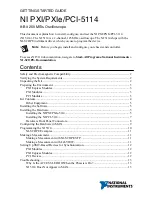
NI-SCOPE Examples
Examples demonstrate the functionality of the device and serve as programming models and
building blocks for your own applications. The NI Example Finder is a utility available for
some ADEs that organizes examples into categories and allows you to easily browse and
search installed examples. You can see descriptions and compatible hardware models for each
example, or see all the examples compatible with one particular hardware model.
To locate examples, refer to the following table.
Table 3.
Locating NI-SCOPE Examples
Application
Development
Environment (ADE)
Locating Examples
LabVIEW or
LabWindows/CVI
Locate examples with the NI Example Finder. Within LabVIEW
or LabWindows/CVI, select
Help
»
Find Examples
, and navigate
to
Hardware Input and Output
»
Modular Instruments
.
ANSI C or Visual Basic
Locate examples in the
<NIDocDir>\NI–SCOPE\examples
directory, where
<NIDocDir>
is one of the following directories:
•
Windows 8/7/Vista—
Users\Public\Public
Documents\National Instruments
•
Windows XP—
Documents and Settings\All Users
\Shared Documents\National Instruments
Making a Measurement
You can make a measurement interactively using the NI-SCOPE SFP or programmatically
using LabVIEW.
Making a Measurement with NI-SCOPE SFP
1.
Connect CH 0 to input signal PFI 1 using an SMB cable.
2.
Launch the NI-SCOPE SFP from the
Start
menu.
3.
In the
Select Device
dialog box, select the device name assigned to the device in MAX.
4.
To enable signal output on PFI 1, activate the probe compensation by selecting
Utility
»
Probe Compensation
.
5.
Click
Auto
to display the data as a square wave.
6.
If the SFP is not already running, click
Run
.
Making a Measurement with LabVIEW
1.
Launch LabVIEW.
2.
Select
Help
»
Find Examples
.
NI PXI/PXIe/PCI-5114 Getting Started Guide
|
© National Instruments
|
11


























